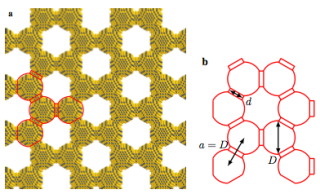
Image Credit: Rawpixel | Shutterstock.com
Physicists at Utrecht University have theoretically designed the 'holy grail' of material science. The material possesses graphene’s special electronic properties along with some properties which graphene does not have at room temperature.
 Honeycomb lattice of HgTe spheres. Hg atoms are in yellow, Te atoms are in grey.
Honeycomb lattice of HgTe spheres. Hg atoms are in yellow, Te atoms are in grey.
Graphene's Honeycomb Structure
Graphene can be thought of as a tightly packed layer of carbon atoms which are bonded together in a hexagonal honeycomb lattice. This new 'holy grail' material developed by the team at Utrecht University has the same structure as graphene but is comprised of nanocrystals of tellurium and mercury instead of carbon.
The team of physicists at Utrecht University have demonstrated in their study that this 'holy grail' material possesses the same properties of graphene as well as some properties which graphene does not have.
The Quantum Spin Hall Effect
This new material is not a conductor at room temperature but is a semiconductor instead. As a result, it can be used as a field-effect transistor. At room temperature, it may host the quantum spin Hall effect, and therefore it meets the conditions necessary for realizing quantum spintronics.
If we manage to synthesize this ‘holy grail’ and it exhibits the theoretically predicted properties, a new field of research and applications opens up we can’t phathom yet.
Prof. Cristiane Morais Smith, Utrecht University
The electrons within a sheet of graphene behave as if they do not posses mass. This phenomena is due to the honeycomb structure of the carbon atoms within graphene. This causes the electrons to behave as if they were relativistic particles.
However, the quantum spin Hall effect cannot be realised even at temperatures that are very low. In order to overcome this obstacle, the researchers at Utrecht University had to create a material that had the ability to realize the quantum spin Hall effect in a honeycomb structure even at room temperature.
Using Mercury Tellurate
Although the quantum spin Hall effect was first theoretically predicted in 1971, it was only experimentally demonstrated in 2006 by Prof. Laurens Molenkamp of the University of Würzburg. Mercury telluride/cadmium telluride quantum wells were used at very low temperatures.
In this new study, the team at Utrecht University designed the honeycomb structures using mercury telluride nanocrystals and studied their properties. They found that a number of structures had the desired properties of the 'holy grail' material. Prof. Daniël Vanmaekelbergh at Utrecht University had previously used cadmium-selenide nanocrystals to synthesise these types of honeycomb structures.
However, at the moment Prof. Laurens Molenkamp is the only expert in the world working with mercury telluride. So we are happy that he is very interested in synthesizing the honeycomb structures we designed with mercury telluride.
Prof. Cristiane Morais Smith, Utrecht University
Prof. Smith went on to comment: “Although it is not yet possible to realise it experimentally, he expects that the technology necessary will be available within a short time, given the developments that are going on in his lab right now. If we succeed in synthesizing it and the material indeed exhibits the unique combination of exotic properties at room temperature as we predicted, a field of fundamental research and technological innovations opens up that lies beyond our imagination.”
Spintronics Applications
This new material could be very useful for use in spintronics technology, which may be the next step in the quest for increasingly quick computer systems. Traditional computer systems use electrical charge to store information but in spintronics electron spin is used instead.
The rotation of electrons in the clockwise or counter-clockwise directions is described by 'spin up' and 'spin down' states. A spin current is created when all the electrons with 'spin up' move to the left and all the electrons with a 'spin down' state move to the right. Nanomagnets and spin currents can interact with each other and this can lead to applications associated with quick reading and writing of magnetic memories.
The Publication of the 'Holy Grail'
The findings of this study have been published in Nature Communications in a paper entitled: 'Topological states in multi-orbital HgTe honeycomb lattices'.